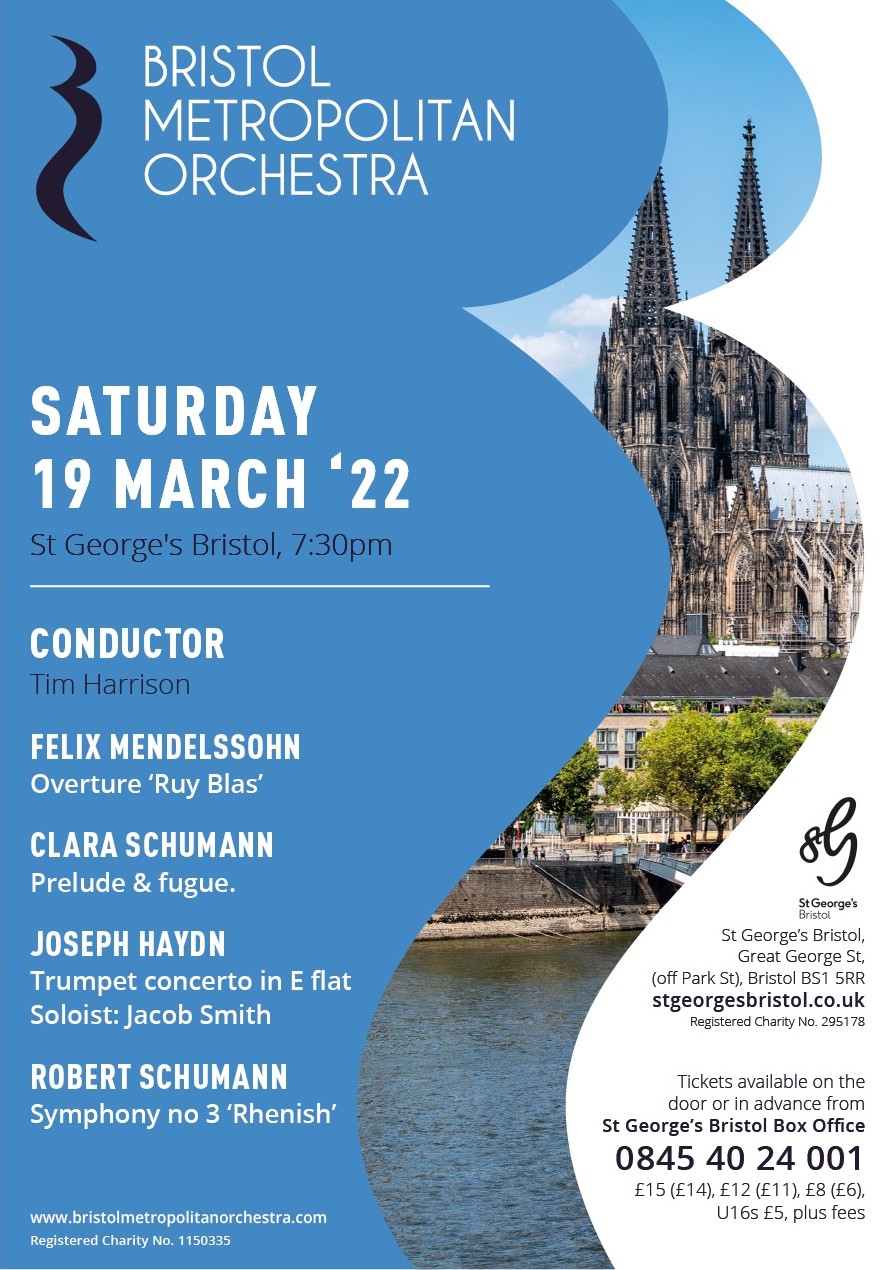Concert: Sat 19 Mar 2022
Venue:St George's Bristol
Conductors:Tim Harrison
Soloist:Jacob Smith (Trumpet)
Start time:19:30
Programme
| Mendelssohn: | Overture Ruy Blas |
| Clara Schumann: | Prelude and Fugue in B flat op 16 (orc Bersweden) |
| Haydn: | Trumpet Concerto |
| Schumann: | Symphony No 3 The Rhenish |
| Brahms: | Hungarian Dance No 1 |
Our concert programme is based on a theme of close friendship between the Romantics of Mendelssohn, Brahms and both Robert and Clara Schumann.
These early romantics were all inspired by the likes of Mozart and Haydn, not only in energy and motific development, but also buying into their classical forms. Schumann also used Haydn’s London Symphonies as inspiration for his trumpet and horn calls in the second symphony. It was the availability of the new keyed trumpet that changed brass writing forever and Haydn was one of the first to take full advantage of it in his Trumpet Concerto in E flat.
Mendelssohn was a musical entrepreneur, without whose conviction and research, we would be far less familiar with composers such as Bach and Schumann. He was a great support to those around him including both Robert and Clara Schumann. Much like the well-polished public facade of the character Ruy Blas, behind this was an altogether different personality. Mendelssohn didn’t take to the story and libretto of Ruy Blas but did at least sketch a concert overture which references the drama to follow.
Clara Schumann was a prominent piano virtuoso of her time and devoted much of her adult life raising her eight children and supporting her husband achieve success, both during his lifetime and after his death. She was a superb composer in her own right but wasn’t given the time to devote to it (which Robert felt deeply guilty about). Both Clara and Robert felt that one of their compositional weaknesses was counterpoint. They embarked on joint projects and wrote piano fugues together. During this period, Clara wrote Three Preludes and Fugues; the Prelude and Fugue in B flat features prominent perfect fourths (also the starting interval of the subject). Later, Robert Schumann included a fugue in ‘Feierlich’ in the Third Symphony. It’s rooted in the minor key but bears many analytical similarities to that of his wife’s fugue, especially the use of the rising perfect fourth (which is the main motif of the symphony). This will be the first orchestral performance of Clara Schumann's Prelude and Fugue in B flat, orchestrated by Bristol composer Esther Bersweden.
Robert Schumann was strongly affected by the death of his close friend, billiard playing, string quartet colleague and supporter, Felix Mendelssohn. Schumann’s mental health deteriorated and suffered greatly with night terrors and hallucinations. This led to an attempted suicide. It was at the beginning of this decline that the third symphony was written as his final major work (the fourth symphony was in fact an earlier work but published later). Eventually, Robert Schumann was taken to an asylum and for the entire two years of his stay at the institution, family friend Brahms visited him regularly.

